
Ornamental Horticulture-Revista Brasileira de Horticultura Ornamental
Scope & Guideline
Shaping the Future of Ornamental Plants
Introduction
Aims and Scopes
- Innovative Cultivation Techniques:
Research on new methods for cultivating ornamental plants, including hydroponics, semi-hydroponics, and the use of biostimulants to enhance growth and postharvest quality. - Plant Physiology and Biochemistry:
Studies examining the physiological and biochemical responses of ornamental plants to various treatments, such as growth regulators, stress factors, and postharvest handling. - Sustainable Practices in Ornamental Horticulture:
Exploration of sustainable practices including organic production, the use of biodegradable materials, and the conservation of native species for ornamental use. - Genetic and Breeding Research:
Investigations into the genetic improvement of ornamental species through breeding programs, focusing on traits such as flower quality, disease resistance, and environmental adaptability. - Postharvest Management:
Research on extending the vase life and quality of cut flowers through various preservation techniques, including the application of preservatives and innovative storage solutions. - Ethnobotanical and Economic Studies:
Analysis of the economic viability of ornamental plant production and the cultural significance of ornamental plants in different regions.
Trending and Emerging
- Sustainable and Eco-friendly Practices:
There is a notable increase in research focusing on sustainable practices in ornamental horticulture, including the use of organic fertilizers, biopesticides, and environmentally friendly cultivation methods. - Biotechnology in Floriculture:
Emerging studies utilize biotechnological methods, such as tissue culture and genetic engineering, to enhance the propagation and quality of ornamental plants, indicating a trend towards innovation. - Stress Management in Ornamental Plants:
Increasing attention is being given to understanding how ornamental plants respond to abiotic stresses (like salinity and drought) and how to mitigate these effects through various treatments. - Integration of Technology in Horticulture:
Research is trending towards the application of technologies such as artificial intelligence and sensor systems for monitoring plant health and optimizing growth conditions. - Consumer Behavior and Market Analysis:
Emerging studies focus on understanding consumer preferences and market dynamics in the ornamental plant sector, particularly in the context of the COVID-19 pandemic and changing consumer behaviors.
Declining or Waning
- Traditional Breeding Techniques:
Research on conventional breeding methods appears to be declining as more emphasis is placed on biotechnological approaches and genetic engineering for plant improvement. - Generalized Ethnobotanical Studies:
While ethnobotanical studies remain important, there is a noted shift from broad ethnobotanical surveys to more specific investigations that focus on practical applications and management strategies. - Basic Morphological Studies:
Basic studies focusing solely on morphological traits without linking them to physiological or biochemical implications are becoming less common, as researchers aim for more integrative approaches. - Historical and Descriptive Research:
The journal seems to be moving away from purely historical or descriptive studies of ornamental plants in favor of research that offers direct applications or innovative solutions to current challenges.
Similar Journals
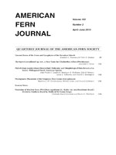
AMERICAN FERN JOURNAL
Celebrating the Beauty and Importance of FernsAMERICAN FERN JOURNAL, published by AMER FERN SOC INC, is a pivotal resource for researchers and enthusiasts in the fields of Ecology, Evolution, Behavior, and Plant Science. With a publication history dating back to 1993 and extending through 2024, this journal serves as a critical platform for the dissemination of knowledge related to ferns and lycophytes, contributing significantly to taxonomic and ecological studies. While it currently holds a Q4 rank in Ecology, Evolution, Behavior and Systematics and a Q3 rank in Plant Science, the journal continually strives to improve its relevance and impact within the scientific community. Researchers can access its valuable content through conventional subscription models, providing curated articles that advance the understanding of fern biodiversity and conservation. This journal is essential for anyone devoted to the exploration and preservation of these vital plant groups, offering insights that are not only relevant to academic circles but also inspire the broader public to appreciate the beauty and importance of ferns in our ecosystems.

MITTEILUNGEN KLOSTERNEUBURG
Cultivating Knowledge, Growing InnovationMITTEILUNGEN KLOSTERNEUBURG is a prestigious journal published by the Höhere Bundeslehranstalt & Bundesamt für Wein- und Obstbau Klosterneuburg in Austria, focusing on the fields of horticulture and agricultural sciences. With an ISSN of 0007-5922, this journal disseminates vital research findings and advancements within the horticultural sector, emphasizing sustainable practices and innovative techniques in wine and fruit cultivation. It has been recognized for its scholarly contributions, achieving a Q3 ranking in horticulture as of 2023, positioning it among the notable resources in its field. While currently not offering open access options, MITTEILUNGEN KLOSTERNEUBURG remains an essential platform for researchers, professionals, and students alike, fostering knowledge exchange and collaborative advancements in horticultural science. The journal's dedication to supporting research from 1989 through 2024 highlights its longstanding commitment to excellence in the industry.
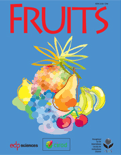
Fruits
Connecting Global Experts in Horticultural Research.Fruits, published by the International Society for Horticultural Science (ISHS), is a pivotal journal in the fields of Agronomy, Food Science, and Horticulture. Since its inception in 1995 and with a continued publication from 2001 to 2024, this journal provides a platform for innovative research and advancements related to fruit science, covering an array of topics from cultivation techniques to post-harvest processing. With an ISSN number of 0248-1294 and an E-ISSN of 1625-967X, *Fruits* engages a global audience, operating out of France and serving as a vital resource for academics, industry professionals, and students alike. Despite its current categorization as Q4 in Agronomy and Crop Science and Q3 in both Food Science and Horticulture, the journal is committed to fostering high-quality research and enhancing its visibility within the academia, as reflected in its Scopus rankings. Readers can expect rigorous peer-reviewed articles that contribute significantly to the understanding of fruit-related science, ultimately driving the advancement of sustainable practices in the field. Emphasizing accessibility, while currently not open access, *Fruits* remains dedicated to disseminating valuable knowledge to enhance the communal pursuit of excellence in horticultural research.

JOURNAL OF THE PROFESSIONAL ASSOCIATION FOR CACTUS DEVELOPMENT
Nurturing Knowledge in Cactus CultivationJOURNAL OF THE PROFESSIONAL ASSOCIATION FOR CACTUS DEVELOPMENT is an esteemed publication within the fields of Horticulture and Plant Science, managed by the Professional Association for Cactus Development. With its ISSN 1938-663X and E-ISSN 1938-6648, this journal stands as a vital platform for disseminating research and innovative practices concerning the growth, cultivation, and conservation of cacti. Despite being categorized in the Q4 quartile for both Horticulture and Plant Science in 2023, it provides invaluable insights and breakthroughs that are crucial for advancing knowledge and practices in this specialized area of study. The journal, which has been published consistently from 2003 to 2011 and from 2013 to 2024, encourages contributions from researchers, professionals, and students alike, fostering a community dedicated to the sustainable development of cactus species. Although currently not indexed with an impact factor or H-index, its targeted readership can access essential information to enhance both academic and practical applications within the horticultural sciences. For submission guidelines and further details, authors and readers are encouraged to visit the journal's official site.

Erwerbs-Obstbau
Empowering Agricultural Practices with Research.Erwerbs-Obstbau is a pivotal journal dedicated to the field of horticulture, focusing on research concerning the cultivation and production of fruit. Published by Springer in Germany, this journal plays a crucial role in disseminating innovative findings and advancing the knowledge base within the agricultural and biological sciences landscape. With an impact factor that places it in the Q3 category of horticultural journals, it ranks #68 out of 115 in its field according to Scopus, demonstrating its relevance and contribution to ongoing debates and advancements in horticulture practices. Researchers, professionals, and students benefit from the insights and developments shared in its pages, as the journal has been successfully converging data and insights since its inception in 1983, including continuous contributions from 1996 to the present. Although the journal currently does not offer Open Access, its comprehensive articles are invaluable for anyone invested in the science of fruit cultivation and production.
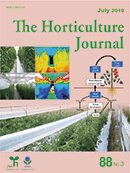
Horticulture Journal
Transforming Horticultural Research into PracticeThe Horticulture Journal, published by the Japan Society for Horticultural Science, is a leading academic platform dedicated to the advancement of horticultural research and practices. With an ISSN of 2189-0102 and an E-ISSN of 2189-0110, this journal endeavors to publish high-quality research that emphasizes innovative techniques, sustainable practices, and the science of plant cultivation. The journal has been recognized for its impact within the field, currently holding a Q2 ranking in Horticulture and a Q3 ranking in Plant Science as of 2023, indicating its significant contribution to advancing knowledge. With its open-access model, researchers, professionals, and students have the opportunity to engage with the latest findings, thanks to the journal's commitment to widespread dissemination of information. Since its convergence period began in 2015 and continuing through to 2024, the Horticulture Journal remains instrumental in promoting sustainable and beneficial practices in horticulture science globally.
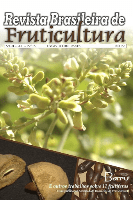
Revista Brasileira de Fruticultura
Showcasing Excellence in Brazilian Horticultural ScienceRevista Brasileira de Fruticultura, published by the Sociedade Brasileira de Fruticultura, is a leading scholarly journal dedicated to the advancement of research in the fields of agronomy, crop science, food science, horticulture, and plant science. With an impressive Open Access model adopted since 2001, the journal is committed to disseminating high-quality research from Brazil and beyond, promoting innovation and collaboration among researchers, professionals, and students alike. The journal currently holds a respectable Q3 category ranking in multiple fields as of 2023, reflecting its significance within the scientific community, specifically ranked #72 in horticulture and #257 in agronomy, among its peers. The Revista Brasileira de Fruticultura not only serves as a platform for original research articles, reviews, and case studies but also emphasizes practical applications and sustainable practices in fruit cultivation. Its aim is to enhance the visibility of Brazilian fruit research on a global scale, making it an invaluable resource for those invested in advancing horticultural sciences.
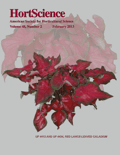
HORTSCIENCE
Exploring the forefront of horticultural research.HORTSCIENCE is a prestigious journal published by the American Society for Horticultural Science, focusing on the latest research and developments in the field of horticulture. With an ISSN of 0018-5345 and an E-ISSN of 2327-9834, this journal has established itself as a vital resource for horticultural scientists, practitioners, and educators since its inception. As of 2020, it has embraced an Open Access model, promoting the dissemination of scientific knowledge and enabling wider accessibility to its rich content. HORTSCIENCE currently holds a Q2 ranking in the Horticulture category for 2023, placing it in the top tier of its field with a Scopus rank of 36 out of 115 in the area of Agricultural and Biological Sciences. This journal publishes empirical research, significant advancements, and comprehensive reviews that contribute to the understanding and improvement of horticultural practices, making it an essential publication for anyone involved in horticultural research or education.

Scientific Papers-Series B-Horticulture
Nurturing Ideas, Harvesting Solutions in Horticulture.Scientific Papers-Series B-Horticulture is a distinguished open-access journal published by the University of Agronomic Sciences and Veterinary Medicine Bucharest. With its ISSN 2285-5653 and E-ISSN 2286-1580, this journal has been accessible to the global research community since 2002, ensuring that vital horticultural research reaches a wide audience without barriers. Positioned at the forefront of the horticultural sciences, the journal serves as a platform for original research, reviews, and innovations pertaining to horticultural practices, plant physiology, and sustainable agriculture. Its contributions are not just significant in Romania but also resonate through the international scientific community, helping to address pressing agricultural challenges. The office located at 59 Marasti Boulevard, District 1, Bucharest 011464, Romania, symbolizes its commitment to advancing horticultural knowledge and fostering collaboration among researchers, professionals, and students alike. With no current H-index data, the journal invites continued contributions to enhance its visibility and impact in the field.

Horticulture Environment and Biotechnology
Elevating Plant Science for a Sustainable FutureHorticulture Environment and Biotechnology is a prestigious journal published by the Korean Society of Horticultural Science, dedicated to advancing knowledge in the fields of horticulture, biotechnology, and plant science. Since its inception in 2011, this journal has played a crucial role in disseminating high-quality research, evidenced by its 2023 category quartile rankings, which position it in Q1 for Horticulture and Q2 for Biotechnology and Plant Science. With impressive Scopus rankings, including Rank #18 out of 115 in Horticulture, the journal continues to demonstrate its significance within the academic community by contributing to innovative practices and findings that impact both environmental sustainability and horticultural advancements. Currently, the journal is accessible to a global audience, facilitating the exchange of ideas and research outcomes with no open-access fees. Horticulture Environment and Biotechnology strives to support researchers, professionals, and students alike by providing a platform for critical discussions on the intersection of horticultural science and biotechnology, thereby fostering the development of sustainable agricultural practices that align with contemporary challenges.